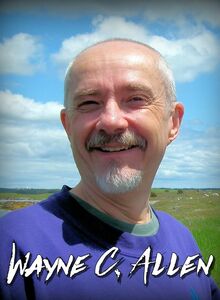
Wayne C. Allen
Kitchener
Wayne C. Allen started painting back in the '60s. He loves exploring the colours found in the shadows. His photographs are the main source for his paintings
Message
I suppose that my “arts education” began in College, at Elmhurst College (now University.) I’d painted a couple of things, in oil, while in High School, and they were “ok-ish.” But then… Art class.
The very first thing we were asked to do was to paint a portrait from a live model. Being me, I painted her on plexiglass, and mounted the plexiglass on a box full of twinkling lights.
The next painting was taken from a “Life” or “Look” cover (magazines, for those of you younger than me.) It was a photo of a mom, dad, and baby, cuddling. I loosened the image up a bit, but my colour palette was pretty bland.
My art Prof gave me an “A”, but then, fatefully, asked me, “Can’t you see the colours in the shadows?”
Given the amount of recreational substances he and the rest of us were taking back then, I guessed he was tripping.
After I graduated in 1973, I pretty much stopped painting, focussing instead on photography. (And… you know… makin’ a livin’.) I worked at a bank to pay the bills. Some years passed as I focussed on photography. I opened a studio in a suburb of Chicago, and did model photos, figure studies, and ad work.
After moving to Canada in ’75, I of course opened a studio, and kept doing photos.
Flash forward to the early 80s. I tripped over some art supplies, and decided to start painting again. The paintings were large, and took forever, as I’d discovered photo-realism. I think I was initially enamoured with photo-realism because I’d spent so many years learning to take good photos.
I went through quite the hyper-realism stage; a couple of my paintings from way back then have an almost photographic quality. The downside, for me, was that the images have a bit of a “flatness” to them.
From 2000 through 2010, I began to loosen my style. Much of my work back then features a more stylistic, “blocked colour” technique. In keeping with my art prof's question, I produced several paintings that feature the play of light and shadow.
I won’t waste a lot of your time on Art Theory, but suffice it to say I’m not a fan of Abstract Art and I'd done all I could with hyper-realism. I chose the middle ground.
I saw my path, and’s called Figurative Art.
To quote Wikipedia: “Figurative art, sometimes written as figurativism, describes artwork (particularly paintings and sculptures) that is clearly derived from real object sources and so is, by definition, representational. The term is often in contrast to abstract art:...Since the arrival of abstract art the term figurative has been used to refer to any form of modern art that retains strong references to the real world.https://en.wikipedia.org/wiki/Figurative_art
This “real world, focus” fit for me. My brain just doesn’t compute abstraction. I like the “here and now” reality of figurative art (I’m a simple Zen guy, after all.) Realism dictates an almost exact matching of what is “right there.” In a figurative world, the realism remains, but is “overwritten” by the artist’s vision of how to bring out the emotions contained in the scene.
Figurative art is a way of expressing what I’m seeing... beyond the details. Each painting I create has a very real basis in reality, but also captures a playful sense of emotion–the colour in the shadows!
I’ve always loved the human form, and that also features heavily in my art. In a sense, it dovetails with my love for photography.
I finally settled on the perfect blend of figurative art and stylistic art around 2016. My commissioned portrait style “locked in” and seems “easy.” The result is a body of work that "visits" three themes: nude figure studies, portraits, and “scenes from everyday life.” In each case, I follow my instinct to produce paintings that are identifiable as “mine.”
My process is to take a photo (or download an image) and to use a computer to edit it. I have a sense of where I want to end up and the technology means I’m able to shift colours, backgrounds, body shapes and positions, etc. before I transfer the image to canvas.
Figurative art needs a strong basis in reality; but I don’t believe it has to be “accurate.” It’s possible for creative expression to marry itself with my artistic vision.
I (finally!) found my niche.
Now retired (I spent 32 years as a psychotherapist) Darbella and I have spent the last decade travelling.
Dar tends to be the “scenic” photographer, and she’s amazing at it.
I continue to look for people and situations that interest me, and then turn the photos into paintings.
And some of my paintings and photographs are available as limited edition prints and wall art.
Please, enjoy!
Powered by Artwork Archive